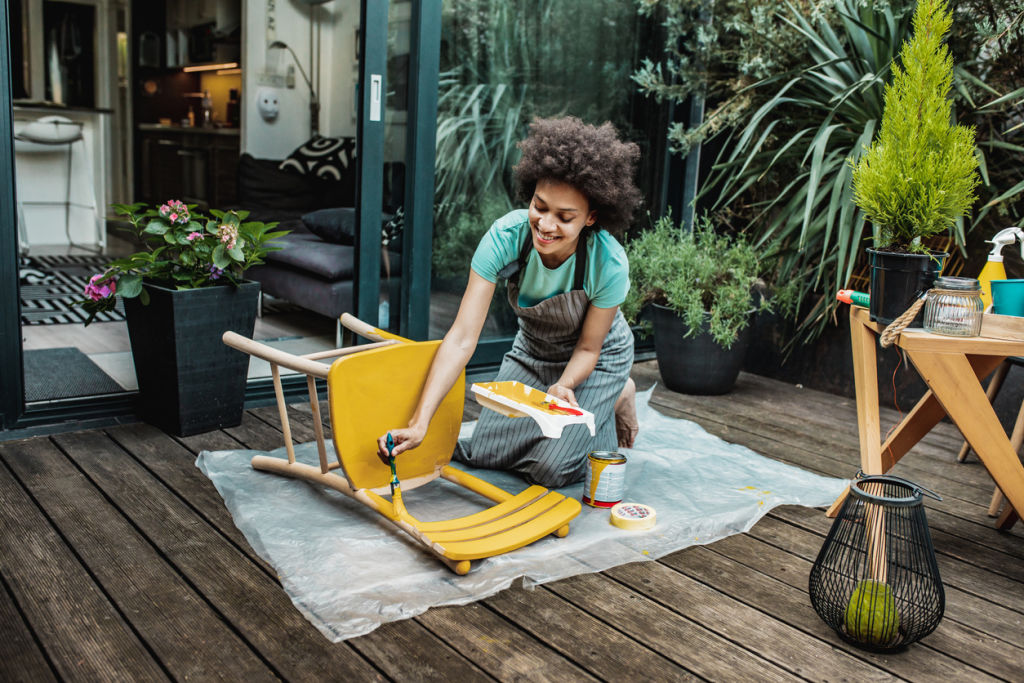How to buy second-hand, flip, then furnish your home like a pro

There are two types of Facebook users: those who preach about the fruits of Facebook Marketplace and those who are overwhelmed by just how much is for sale.
In 2020, Facebook Marketplace saw a 19 per cent growth in total marketplace listings in Australia compared to the previous year; furniture and household were the top two categories.
The Melbourne-based creatives behind boutique design agency and Instagram account Haus of Cruze, Az and Jamie, are a part of the trend.

As experts in interior design, styling and DIY, they say trawling through Facebook Marketplace is integral to their design process – an ethos that isn’t the norm for most in the industry.
“Once you start on Facebook Marketplace, you’ll never understand why you didn’t use it to begin with,” Az says.
“We are very budget-savvy ourselves within our home. I’m literally the first one to jump onto Facebook [Marketplace] most of the time. Now more than ever, it’s such a fantastic place for one-of-a-kind pieces that can amplify a space with a story.”

“It’s always that age-old saying ‘someone’s trash is another man’s treasure’. Facebook Marketplace definitely allows us to do that.”
A quick search in Sydney digs up an on-trend travertine coffee table for a cool $275 and a West Elm forest green sofa for a cool $300. The pair recommend finding your wall art from the platform. “Vintage paintings are something we’ve really started looking for,” Jamie says. “They don’t necessarily need an up-cycle. Occasionally, we’ll put a new frame on it.”
But not all second-hand finds are created equal. While some pieces will be charming as-is, some will need a literal and metaphorical polish to really shine.

“The 2021 interior design trends are leaning more into that vintage kind of vibe with people introducing key pieces that are those unique little golden nuggets you find. You don’t necessarily need to flip them or upcycle them,” Az says.
The first step to nailing the ultimate Facebook Marketplace furniture flip is having a vision and setting up the right notifications.
“We go in for a game plan for a specific item, to begin with,” Jamie advises. “Some of the tips that we’d give to be successful is to save your searches for anything specific. Make sure you turn notifications on as well. It allows us to jump on and grab that bargain before anyone else can find it.”

Az and Jamie had the idea to flip a church pew. A Marketplace search and $50 later, they had the perfect item to fill a spot in one of their client’s home – with a bit of elbow grease.
“We love the idea of a church pew because it’s unconventional,” Az says. “Because a lot of church pews are solid timber or mahogany – and not that attractive – we sanded it back to get the oil and varnish off it. Then we painted everything in a bold, vivid white. It creates a great focal point.”
For items with doorknobs or handles, Az says it’s “essential” to update these. Platforms like eBay, Amazon and Etsy have an affordable selection.

Timber furniture flips can be daunting for a new DIY-er, but a few quality tools and the right research is all that is needed.
“You don’t really need that many tools at all. What we would recommend, especially for those bigger pieces like a church pew, is to use an electric or battery-powered sander. Absolutely worth the investment. It’s worth its weight in gold,” Az says.
Anyone who has walked into a hardware store knows there are almost as many paint finishes as there are colours these days.
“Understand what ‘type’ of paint to use for the specific furnishing you’re flipping,” Az says. “Know what look you’re going for before you buy paint or a spray can off the shelf. Do a bit of research beforehand.”
A paint primer will make life a whole lot easier – as will a small roller if you have the budget to buy beyond a paintbrush. Most sample pots have enough paint for two coats on smaller items like chairs to keep costs down.
A semi-gloss finish is popular for furniture as it offers more durability than a satin finish but shows fewer imperfections than a high-gloss finish.
For a more matt look, which works particularly well on vintage furniture, consider getting experimental with chalk paint. For a smoother, less textured finish, look for matt or flat finishes.
Az and Jamie’s tips for flipping furniture like a pro:
- Set up notifications on Facebook Marketplace, so you don’t miss a bargain.
- Consider unconventional items not found in the home – like church pews, office clear-outs, old school furniture.
- Invest in an electric or battery-operated sander.
- Don’t flip everything you find. Some vintage pieces are better left to shine as-is.
- Replace handles and knobs to instantly elevate an item.
- Looking for unique art? Find prints second-hand and swap or up-cycle the frame.
- Research what paint is required for your piece before buying. Semi-gloss is popular for timber furniture.
We recommend
States
Capital Cities
Capital Cities - Rentals
Popular Areas
Allhomes
More
- © 2025, CoStar Group Inc.










